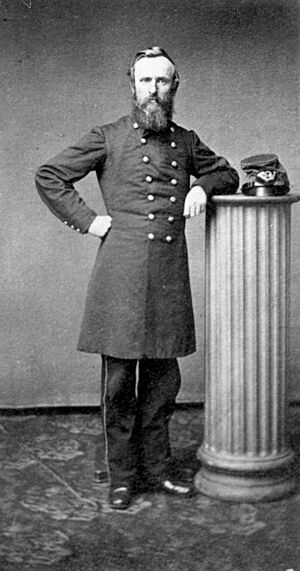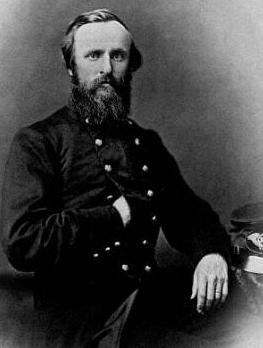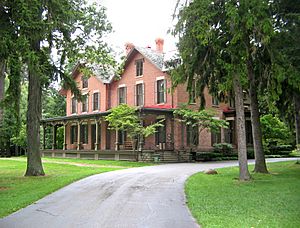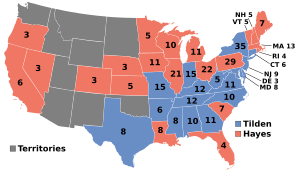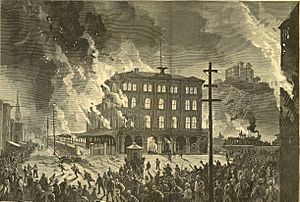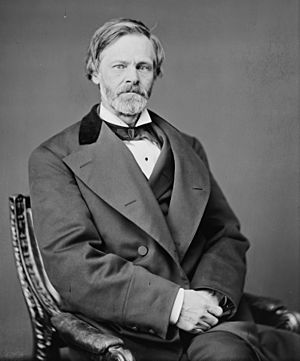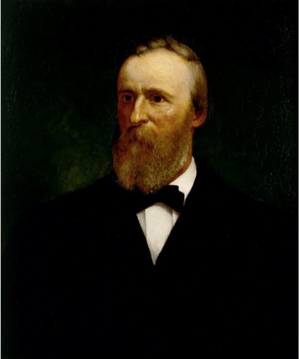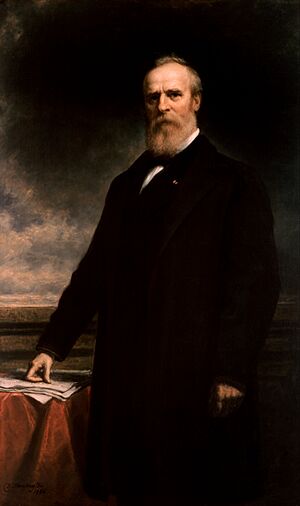Rutherford B. Hayes facts for kids
Quick facts for kids
Rutherford B. Hayes
|
|
|---|---|

Portrait by Mathew Brady, c. 1870–1880
|
|
| 19th President of the United States | |
| In office March 4, 1877 – March 4, 1881 |
|
| Vice President | William A. Wheeler |
| Preceded by | Ulysses S. Grant |
| Succeeded by | James A. Garfield |
| 29th and 32nd Governor of Ohio | |
| In office January 10, 1876 – March 2, 1877 |
|
| Lieutenant | Thomas L. Young |
| Preceded by | William Allen |
| Succeeded by | Thomas L. Young |
| In office January 13, 1868 – January 8, 1872 |
|
| Lieutenant | John Calvin Lee |
| Preceded by | Jacob Dolson Cox |
| Succeeded by | Edward Follansbee Noyes |
| Member of the U.S. House of Representatives from Ohio's 2nd district |
|
| In office March 4, 1865 – July 20, 1867 |
|
| Preceded by | Alexander Long |
| Succeeded by | Samuel Fenton Cary |
| Personal details | |
| Born |
Rutherford Birchard Hayes
October 4, 1822 Delaware, Ohio, U.S. |
| Died | January 17, 1893 (aged 70) Fremont, Ohio, U.S. |
| Resting place | Spiegel Grove State Park |
| Political party |
|
| Spouse | |
| Children | 8, including Webb C. Hayes and Rutherford P. Hayes |
| Relatives | Carl Edwards (great-great-great grandson) |
| Education | |
| Occupation |
|
| Signature | |
| Military service | |
| Allegiance | |
| Branch/service | Union Army (USV) |
| Years of service | 1861–1865 |
| Rank |
|
| Regiments | 23rd Ohio Infantry |
| Commands | Kanawha Division |
| Battles | |
 Crest of Rutherford B. Hayes |
|
Rutherford Birchard Hayes (October 4, 1822 – January 17, 1893) was the 19th president of the United States. He served from 1877 to 1881. Before becoming president, he was a lawyer, a soldier, and the governor of Ohio.
Hayes was a strong supporter of ending slavery. As a lawyer, he defended enslaved people who had escaped. During the American Civil War, he joined the Union Army. He was wounded five times and became a major general. After the war, he served in the U.S. House of Representatives.
His time as president is seen as the official end of Reconstruction. This was a period after the Civil War when the U.S. government tried to rebuild the Southern states. Hayes worked to bring the country back together. He also tried to improve how government jobs were given out.
Contents
Early Life and Education
Childhood and Family
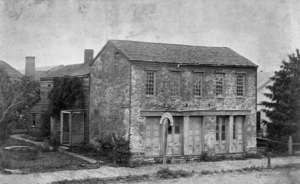
Rutherford Birchard Hayes was born in Delaware, Ohio, on October 4, 1822. His father died before he was born. His mother, Sophia, raised him and his sister, Fanny. His uncle, Sardis Birchard, also lived with them. He became like a father to Hayes and helped with his education.
Hayes's family came from early settlers in New England. His ancestors were from Scotland and England. Many of his relatives lived in Vermont.
School and Law Career
Hayes went to schools in Ohio and Connecticut. In 1838, he went to Kenyon College in Ohio. He was a good student and joined many clubs. He also became interested in politics. He graduated with top honors in 1842.
After college, Hayes studied law. He went to Harvard Law School and graduated in 1843. He became a lawyer in Ohio in 1845. He opened his own law office in Fremont, Ohio. Later, he moved to Cincinnati.
Cincinnati and Marriage
In Cincinnati, Hayes became a successful lawyer. He joined social clubs and attended church. He met and married Lucy Webb on December 30, 1852. Lucy was a Methodist and believed in ending slavery. She influenced Hayes's views on these issues. They had three sons early in their marriage.
Hayes became known for defending people accused of murder. He also defended enslaved people who had escaped. Cincinnati was close to Kentucky, a state where slavery was legal. Many escaped slaves came to Cincinnati. Hayes was a strong supporter of ending slavery. This work helped him become known in the new Republican Party.
In 1858, Hayes was elected as the city's lawyer, called a city solicitor. He won a full two-year term in 1859.
Civil War Service
When Southern states started to leave the United States in 1860, Hayes was not sure about a war. But after the Confederates attacked Fort Sumter, he decided to join the Union Army. In June 1861, he became a major in the 23rd Regiment of Ohio Volunteer Infantry. Another future president, William McKinley, was a private in his regiment.
Battles and Promotions
Hayes and his regiment went to western Virginia. In September 1862, Hayes led a charge at the Battle of South Mountain. He was shot in his left arm, breaking the bone. He tied a handkerchief around the wound and kept leading his men. He was later taken to a hospital.
In October, he was promoted to colonel. He was also made a brevet brigadier general. This meant he had the rank of brigadier general, but it was an honorary title for bravery.
Hayes fought in many battles in 1864. He was wounded again at the Second Battle of Kernstown. He was also thrown from his horse and hit in the head by a bullet at the Battle of Cedar Creek. His bravery impressed his commanders. Ulysses S. Grant later said Hayes showed "conspicuous gallantry."
In October 1864, Hayes was promoted to brigadier general. He was also given the honorary rank of major general. The war ended in spring 1865. Hayes and his regiment returned to Ohio.
After the War: Politics
U.S. Representative

While still in the army in 1864, Hayes was chosen by Republicans to run for the United States House of Representatives. He won the election.
In Congress, Hayes was part of a large Republican majority. He supported the Fourteenth Amendment to the United States Constitution. This amendment gave citizenship and equal rights to all people born in the U.S., including formerly enslaved people. Hayes believed the Southern states should rejoin the Union. But he also thought they needed to protect the rights of newly freed African Americans.
President Andrew Johnson wanted to let the Southern states rejoin quickly. He did not want to make them protect civil rights. Hayes and other Republicans disagreed. They passed laws like the Civil Rights Act of 1866 to protect these rights. Hayes also voted to try to remove President Johnson from office, but it did not pass. He also pushed for changes to how government jobs were given out.
Governor of Ohio
In 1867, Hayes left Congress to run for governor of Ohio. He was a popular choice. He supported giving black men the right to vote in Ohio. He won the election by a small number of votes.
As governor, Hayes helped create a school for deaf people and a reform school for girls. He was reelected in 1869. With more Republicans in the state government, Ohio approved the Fifteenth Amendment to the United States Constitution. This amendment guaranteed black men the right to vote across the country. Hayes also helped establish The Ohio State University. He served two full terms and part of a third.
Return to Private Life and Back to Politics
After his second term as governor, Hayes wanted to retire from politics. He wanted to spend time with his children. He also managed some land he owned.
In 1873, his uncle Sardis Birchard died. Hayes and his family moved into Spiegel Grove, the large house his uncle had built. His uncle also left money to start a public library in Fremont. Hayes helped lead the library's board.
In 1875, Republicans asked Hayes to run for governor again. He accepted and won a third term. He was the first person to do so in Ohio. As governor, he worked to reduce state debt and improve prisons.
The Election of 1876
Republican Candidate
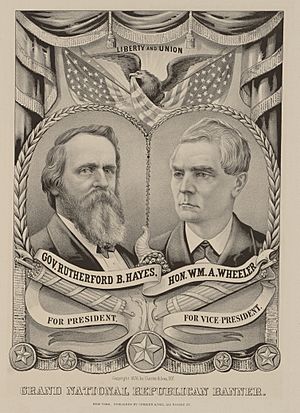
Hayes's success as governor made him a top choice for president in 1876. At the 1876 Republican National Convention, he was chosen as the Republican candidate. William A. Wheeler was chosen as his vice president.
Hayes and Wheeler tried to appeal to people in the South. They wanted to reunite the country. The Democratic candidate was Samuel J. Tilden, the governor of New York. Both men were known for being honest. The economy was not doing well, which made the party in power less popular.
The election was very close. Tilden won the popular vote. But there were problems with the votes in three Southern states: Florida, Louisiana, and South Carolina. Both parties claimed victory in these states.
Disputed Votes and Compromise
After election day, Tilden seemed to have 184 electoral votes, just one short of winning. Hayes had 166. The 19 votes from Florida, Louisiana, and South Carolina were still undecided. If Hayes did not get all 20 disputed votes, Tilden would win.
Congress decided to create a special group called the Electoral Commission. This group would decide who got the disputed votes. The commission had seven Democrats, seven Republicans, and one independent judge. But the independent judge was elected to the Senate and could not serve. So, a Republican judge took his place.
In February 1877, the eight Republicans on the commission voted to give all 20 disputed votes to Hayes. Democrats were very angry. They tried to stop Congress from accepting the decision.
Eventually, Republicans and Democrats made a deal. This was called the Compromise of 1877. Republicans promised to remove federal troops from the South. This meant the end of Reconstruction. In return, Democrats agreed to Hayes becoming president. On March 2, 1877, Hayes was declared the winner by one electoral vote: 185 to 184.
Presidency (1877–1881)
Taking Office
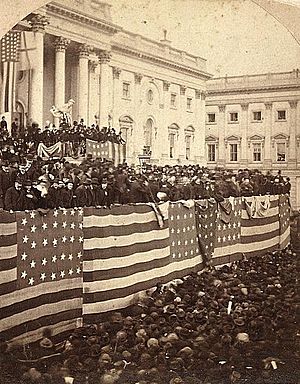
Because March 4, 1877, was a Sunday, Hayes took the oath of office privately on March 3. He was the first president to do so in the White House. He took the oath publicly on March 5 at the U.S. Capitol.
In his speech, Hayes tried to calm the country. He promised to support "peaceful local self-government" in the South. He also promised to reform the way government jobs were given out. Many Democrats still believed Hayes's election was unfair. They sometimes called him "His Fraudulency."
End of Reconstruction
Hayes had supported Reconstruction policies. But his first major act as president was to end it. He ordered federal troops to leave South Carolina and Louisiana. These were the last two states where federal troops were still supporting Republican governments.
Without the troops, these governments soon fell to Democratic control. Hayes tried to protect the rights of African Americans in the South. But his efforts were not successful. Democrats in Congress passed laws that made it harder to enforce voting rights. Hayes vetoed these laws, but Congress found ways to limit funding for enforcement.
Hayes tried to make peace with the South. He wanted to end the divisions from the war. But he could not convince the South to accept equal rights for all races. He also could not get Congress to fund civil rights laws.
Civil Service Reform
Hayes wanted to change how government jobs were given out. Before, jobs were often given to political supporters. This was called the "spoils system." Hayes wanted jobs to be given based on skill and exams. This was called "meritocratic government."
This idea caused problems with some Republicans. They were used to choosing who got jobs. Hayes appointed Carl Schurz to lead a committee to create new rules for government jobs. He also ordered an investigation into the New York Custom House. This was a place where many jobs were given out based on politics.
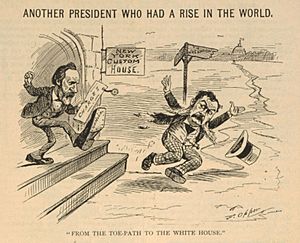
Hayes issued an order that government workers could not be forced to give money to political campaigns. He tried to fire some officials who did not follow this rule. One of them was Chester A. Arthur, who later became president. It took time, but Hayes eventually won this fight. He replaced the officials with people who supported his reforms.
Hayes kept pushing Congress to pass laws for permanent reform. While no big reform law passed during his presidency, his efforts helped lead to the Pendleton Civil Service Reform Act in 1883. This law made it much harder to give government jobs based on political favors.
Hayes also dealt with corruption in the postal service. He stopped new contracts that were part of a corrupt system.
Great Railroad Strike of 1877
In his first year, Hayes faced the biggest labor strike in U.S. history. This was the Great Railroad Strike of 1877. Railroad companies had cut workers' wages several times. In July, workers went on strike in West Virginia. The strike quickly spread across the country.
Governors asked Hayes to send federal troops to stop the riots. Hayes sent troops to Martinsburg, West Virginia, and Baltimore. In Pittsburgh, riots broke out, and Hayes sent troops to protect federal property. This was the first time federal troops were used to break a strike against a private company. The riots ended by July 29.
Money Matters
Hayes dealt with two main issues about money. The first was about silver coins. In 1873, the U.S. stopped making silver coins worth a dollar or more. This meant the dollar was tied only to the value of gold. This made money supply smaller. Farmers and workers wanted silver coins back. They thought it would make money more available and help the economy.
Congress passed the Bland–Allison Act in 1878. This law required the government to coin a certain amount of silver each month. Hayes believed this would cause inflation and hurt businesses. He thought keeping the gold standard was important for the economy. He vetoed the bill, but Congress voted to pass it anyway. This was the only time Congress overrode one of Hayes's vetoes.
The second issue was about "greenbacks." These were paper money issued during the Civil War. They were not backed by gold. A law from 1875 said the government would exchange greenbacks for gold. Hayes and his Treasury Secretary, John Sherman, prepared for this. When the law took effect in 1879, people trusted the greenbacks. Few people actually exchanged them for gold. This helped stabilize the country's money system.
Foreign Policy
Most of Hayes's foreign policy focused on Latin America. In 1878, he helped settle a land dispute between Argentina and Paraguay. Hayes decided in favor of Paraguay. Paraguay honored him by naming a city and a region after him.
Hayes was also worried about a plan to build a canal across Panama. The builder of the Suez Canal, Ferdinand de Lesseps, wanted to build it. Hayes believed the U.S. should control any canal in the Americas. He said the U.S. would not allow European powers to control it.
The border with Mexico also needed attention. Bands of criminals often crossed the border into Texas. Hayes allowed the army to chase them into Mexico. This helped calm the situation. Later, Hayes and the Mexican president agreed to work together to stop the criminals.
Hayes also dealt with China. In 1868, a treaty allowed Chinese immigrants to come to the U.S. freely. But after the economy slowed down, some blamed Chinese immigrants for lower wages. In 1879, Congress passed a law to stop Chinese immigration. Hayes vetoed this bill. He believed the U.S. should not break treaties without talking first. This veto made some people in the Western U.S. angry. Later, a new law was passed to reduce immigration after Hayes left office.
Native American Policy
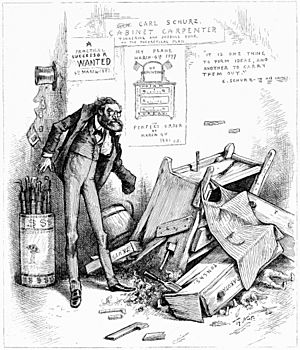
Hayes and his Interior Secretary, Carl Schurz, worked on Native American policy. They wanted to help Native Americans become more like white Americans. They also wanted to divide tribal lands into smaller plots for individual families. Hayes believed this would help Native Americans become self-sufficient. However, this policy, later formalized by the Dawes Act, caused Native Americans to lose much of their land.
Hayes dealt with several conflicts with Native American tribes. The Nez Perce, led by Chief Joseph, started an uprising in 1877. They were forced to move to a reservation. After a long retreat, Chief Joseph surrendered. The tribe was moved to Indian Territory in Kansas.
Another conflict was with the Ute tribe in Colorado in 1879. Some Ute killed an Indian agent. Hayes and Schurz helped negotiate peace. They also prevented white settlers from taking revenge.
Hayes also helped the Ponca tribe. They had been moved from Nebraska to Indian Territory by mistake. Hayes set up a commission that allowed the Ponca to return home or stay on their reservation. They also received money for their land rights.
Great Western Tour of 1880
In 1880, Hayes took a 71-day trip across the Western United States. He was the second president to travel west of the Rocky Mountains. His wife and William Tecumseh Sherman traveled with him.
Hayes started his trip in Chicago. He traveled by train across the country to California. He stopped in Wyoming, Utah, and Nevada. He visited Sacramento and San Francisco. Then, he went north to Oregon and Washington. He also visited Seattle. Hayes then toured some southwestern states before returning to Ohio in November. He was back in time to vote in the 1880 presidential election.
Cabinet and Judges
| The Hayes Cabinet | ||
|---|---|---|
| Office | Name | Term |
| President | Rutherford B. Hayes | 1877–1881 |
| Vice President | William A. Wheeler | 1877–1881 |
| Secretary of State | William M. Evarts | 1877–1881 |
| Secretary of Treasury | John Sherman | 1877–1881 |
| Secretary of War | George W. McCrary | 1877–1879 |
| Alexander Ramsey | 1879–1881 | |
| Attorney General | Charles Devens | 1877–1881 |
| Postmaster General | David M. Key | 1877–1880 |
| Horace Maynard | 1880–1881 | |
| Secretary of the Navy | Richard W. Thompson | 1877–1880 |
| Nathan Goff Jr. | 1881 | |
| Secretary of the Interior | Carl Schurz | 1877–1881 |
Hayes appointed two Associate Justices to the Supreme Court. His first appointment was John Marshall Harlan. Harlan served on the court for 34 years. He often voted to strongly enforce civil rights laws.
His second appointment was William Burnham Woods. Woods was a judge from Alabama. He served for six years on the Court.
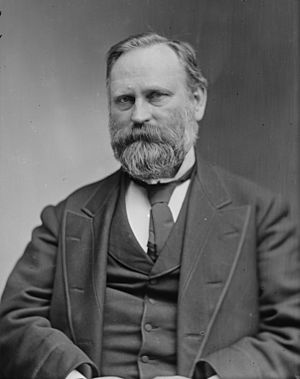
Hayes also tried to appoint his friend, Stanley Matthews, to the Supreme Court. Some senators thought Matthews was too close to big businesses. The Senate did not vote on his appointment. When James A. Garfield became president, he nominated Matthews again. This time, Matthews was approved by a very close vote.
After the Presidency (1881–1893)
Hayes decided not to run for a second term in 1880. He was happy that another Ohio Republican, James A. Garfield, was elected to replace him. After Garfield became president, Hayes and his family moved back to Spiegel Grove.
Hayes became a supporter of education and charities. He believed education could help unite American society. In 1887, he joined the Board of Trustees of Ohio State University. He had helped start this school when he was governor. He believed in teaching job skills as well as academic subjects.
Hayes also spoke out about the difference between rich and poor people. He said that a free government could not last if most of the wealth was in only a few hands. He also supported better conditions in prisons.
Later Life and Death
Hayes was very sad when his wife, Lucy, died in 1889. After her death, his daughter Fanny traveled with him. He also enjoyed visits from his grandchildren.
Hayes died on January 17, 1893, at age 70. He died from heart problems. His last words were, "I know that I'm going where Lucy is." He was buried in Oakwood Cemetery.
Legacy and Honors
Hayes's home, Spiegel Grove, was given to the state of Ohio. He was reburied there in 1915. In 1916, the Rutherford B. Hayes Presidential Center, the country's first presidential library, opened at the site.
In 1878, Hayes helped settle a land dispute between Argentina and Paraguay. He decided in favor of Paraguay. Because of this, a region in Paraguay was named Presidente Hayes Department after him. A city there is also called Villa Hayes. There is even a soccer team named Club Presidente Hayes.
Hayes County, Nebraska, is also named after him.
Rutherford B. Hayes High School in his hometown is named in his honor. Hayes Hall at The Ohio State University is also named for him. It was built in 1893 and is the oldest building still standing at the university.
Images for kids
-
George Crook was Hayes's commander and the namesake of his fourth son
-
Currier & Ives lithograph of the Hayes cabinet in 1877
See also
 In Spanish: Rutherford B. Hayes para niños
In Spanish: Rutherford B. Hayes para niños



